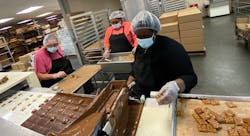In late 2019, Stephanie Stuckey took her life savings and sunk it into a company that was six figures in debt. “Two years later, we’ve gone from six figures in the red to over 1 million in profit, over 10 million in gross sales,” she says.
But let’s take a step back.
85 Years of History
The name “Stuckey” may have you reminiscing–the company and its famous pecan log rolls and candies were a staple of 1960s road trips.
Stephanie’s grandfather, W.S. “Sylvester” Stuckey Sr., founded Stuckey’s Corp. in 1937 during the Great Depression in Eastman, Georgia, the same city where the business is headquartered today. After dropping out of college to work on the family farm, he was looking for a ‘side hustle.’
“Jobs were not to be found anywhere in that time. But there was one thing that was plentiful, and it was pecans,” Stephanie says. “So, he started selling pecans on the side of the road. He would buy them up from farmers, he would shell them, and mark up the price a little bit.”
He was onto something. So, he started making candies and snack nuts. He then started selling cherry cider, locally made quilts and honey, and the evolution of Stuckey’s would continue to expand.
During the company’s heyday, there were 368 Stuckey’s stores in 40 states, they had a distribution facility, a candy plant, a pecan shelling plant, a trucking company and a sign painting company, solidifying Stuckey’s as an icon of the American road trip.
The company continued its journey when it merged with Pet Milk Co. in 1964. However, a Chicago conglomerate, Illinois Central Industries, bought Pet Milk Co. in 1977, and Stuckey’s fell out of family hands, sending the brand into a sharp decline. Adding to these issues were OPEC oil embargos, decreasing the amount of road trips.
Stephanie’s father, W.S. “Billy” Stuckey Jr., was able to get the company back in 1985, but Stuckey’s was on life support, she says. Her father was able to facilitate a revival after pairing Dairy Queen with Stuckey’s for almost 30 years.
When Dairy Queen was sold to Warren Buffett’s Berkshire Hathaway in 1998, Stuckey’s began to falter again. Her father and his business partners started retiring, repeating the up-and-downcycles for the company.
Everything changed in November 2019.
A New Start
“I was literally sitting at my desk, minding my own business, and I got an email asking if I wanted to buy Stuckey’s,” Stephanie Stuckey says. “At the time, I was very flattered because I didn’t have a business background. I was like, well, they see something in me.”
She would soon find out that all of her grandfather’s six living grandchildren had been made the same offer. “I called my siblings and my first cousins, and I said, ‘Hey would y’all want to go in on this with me?’ And they said, ‘Oh, we already turned it down,’” she jokes.
“I took a big risk at age 53. I sunk my life savings. I bought the company,” Stuckey says. “At that point, we did not own or operate any stores, we had 65 licensed locations and we didn’t manufacture our own product anymore. It had been outsourced. And, we were in a rented distribution facility.”
How Did She Do It?
So, what has been Stephanie’s secret for the massive resurgence of her family business? Manufacturing.
“We bought the manufacturing plant in January 2021, and it’s really taken almost a full year to ramp up production and get our recipes online, get our packaging, get the team trained up. So, it’s been a process,” she says. “I feel like we’re just now starting to get our sea legs and starting to roll out the product in more and more places.”
The Stuckey’s shelling and candy plant is in Wrens, Georgia. “We’re making our core product line in house ourselves and, knock on wood, we hopefully very soon will be closing on owning a distribution facility and expanding our candy production.”
From a sustainability standpoint, Stuckey wants to see more support for domestic production. Spurring local economic development and having a relationship with who you do business with streamlines operations, and Stuckey’s is putting these ideals into practice by trying to be more local in where they are getting their packaging.
Stephanie expressed her excitement to be entering a growing industry that is promoting self-reliance.
“I think manufacturing is just an incredible opportunity for an entrepreneur in this country,” she says. “I think enough women don’t really consider that an option… We’re starting to embrace making it ourselves again. I’m really excited about the future of the economy, even though we’ve had some rough times.”
“I looked at what was really making us the most amount of revenue, and it was our core product line, which is the pecan log roll. We have been selling pecan log rolls since the 1930s, and it’s done pretty well for us,” she says. “So, I thought, ‘Do what works, and do more of it.’”
The Road Ahead
Along with their famous pecan log roll, Stuckey’s makes pralines, divinity, gophers, peanut brittle, several varieties of pecans and so much more.
Along with Stuckey’s stores, you can now find them in various chains; Stephanie says to be on the lookout for Stuckey’s in the next year or two at convenience stores, grocery channels, hardware chains, hotel gift shops and local independent community stores, places where the company is focusing on expansion across the country.
The company also has about 45 Stuckey’s Express locations around in 20 states. A concept from her father, expresses are stores within a store, and according to Stuckey, they are expanding on a similar concept. They are selling their product to third-party retailers to sell, and they are working to get special displays to showcase their brand recognition.
Customers can find Stuckey’s mostly in the South, but they are in talks with several national chains about potentially carrying their product, she said.
However, just as the company was beginning to reclaim their original glory, the entire world was interrupted by the COVID-19 pandemic. With the original concept of Stuckey’s being the all-American road trip, there was a need for some serious creativity in a time where travel was extremely limited.
Stuckey’s was forced to drastically change up their distribution channels by increasing focus on the web. They put more product online, updated their website design and offered more curated selections. In addition, other engaging facets of their website include Stuckey’s-themed merchandise and a cleverly named “Stuckey’s Pecan Blog Roll.” By putting their innovation focus in the right areas, web sales increased 650%, she says.
Through the fluctuation of the company over the years, it seems that returning to its roots was the key to the revival; Stephanie believes Americans appreciate a great story, comparing the Stuckey’s journey to that of “Rocky”, her favorite movie. “Who doesn’t love a comeback?”
About the Author
Anna Smith
News Editor
News Editor
LinkedIn: https://www.linkedin.com/in/anna-m-smith/
Bio: Anna Smith joined IndustryWeek in 2021. She handles IW’s daily newsletters and breaking news of interest to the manufacturing industry. Anna was previously an editorial assistant at New Equipment Digest, Material Handling & Logistics and other publications.


